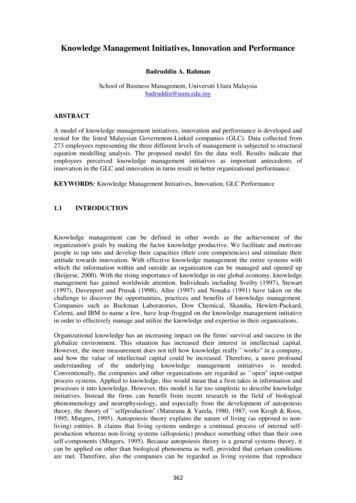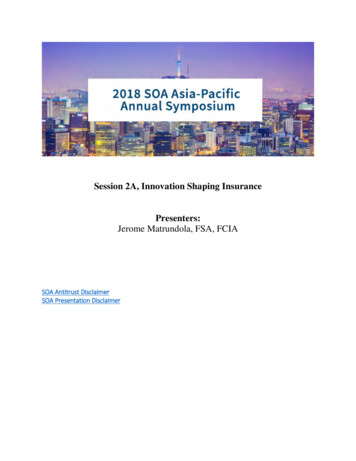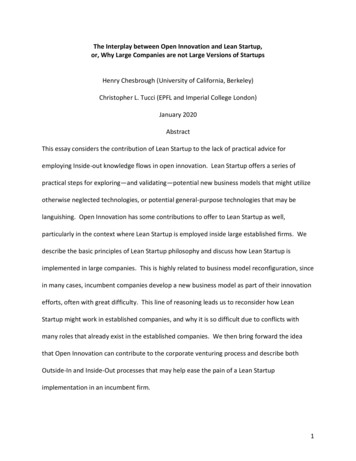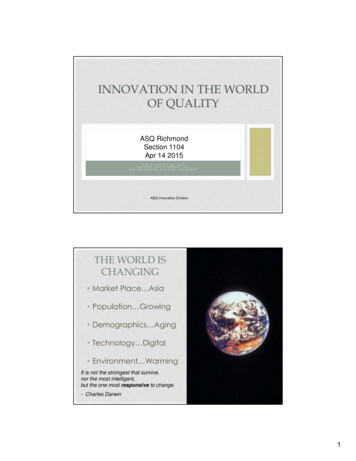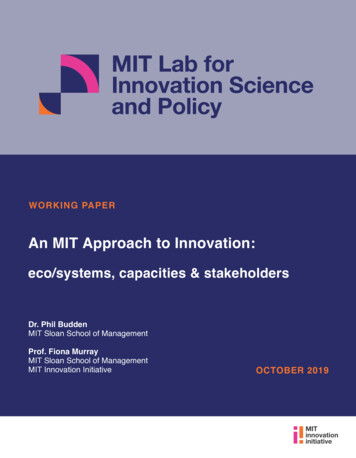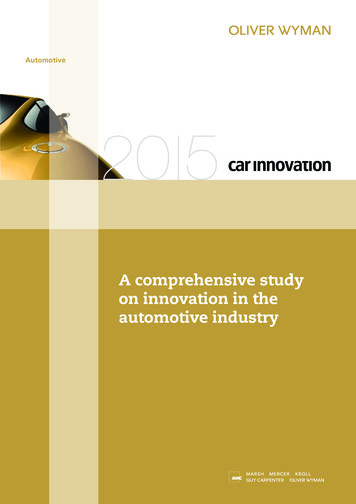
Transcription
AutomotiveA comprehensive studyon innovation in theautomotive industry
ContentsExecutive Summary4Oliver Wyman’s “Car Innovation 2015” studyMegatrends: Innovation Focus6Envision the long-term chances of innovationsCars for an aging populationNew cars for megacitiesDetermine your individual innovation focusTechnology: Innovation Potentials10Recognize technology chances and manage the risks“Car Innovation 2015” technology roadmapChances of and threats to hybrid power trainsChoose and manage the right innovation projectsCustomer: Innovation Acceptance14Include the customer’s perspectiveWhy innovations fail in the eye of customersAssessing the take rate of optional equipmentBuild customer understandingBusiness: Innovation Economics18Keep the system from collapsingBasic figures on R&DThe chances of low-cost designsInnovate your assembly conceptDevise R&D activities to meet the cost agendaStrategy and Organization: Innovation Management22Create an “Innovation Strategy Framework” that suits your needsOEM example: “Architectural revolutionizer”Supplier example: “System connector”Check your “Innovation Strategy Framework”Ten success factorsAreas of action for innovation managersInnovation ConsultingFive consulting services in innovation management30
IntroductionThe changing role of innovationsin the automotive industryDear Reader,In 2001, Mercer Management Consulting (now Oliver Wyman) published a comprehensivestudy titled “Automotive Technology 2010.” Since then, this study has become the basisfor many strategy discussions in the industry and inspired many of our automotiveconsulting projects. Six years later, the new study, “Car Innovation 2015,” continues thistrend-setting work and expands the technological perspective to all aspects of innovations,not just the technological ones.“Car Innovation 2015” analyzes the complete framework of automotive innovations:societal and governmental influences, technology trends, the voice of the customer,innovation economics, and innovation management and strategies. For more than ninemonths, over 30 experts at Oliver Wyman have contributed to “Car Innovation 2015.”The study comprises an in-depth expert poll, a consumer panel, a strategic choiceanalysis, a thorough analysis of more than 300 innovations, a car dealer field study andintensive database research.This brochure introduces the five topics that “Car Innovation 2015” addresses:megatrends, technology, customer, business, strategy and organization. It also containsrecommendations and areas of action involving innovation management at automotivesuppliers and car manufacturers. During 2007, we will publish special brochurescovering each chapter – and, of course, there will be in-depth company presentationsby Oliver Wyman experts to those interested in realizing some of the ideas presentedin the study.Yours truly,Jan Dannenberg and Jan BurgardOliver WymanAutomotivejan.dannenberg@oliverwyman.com 49 89 939 49 473jan.burgard@oliverwyman.com 49 89 939 49 7453
Oliver Wyman’s “Car Innovation 2015” study“Stagnation means regression” to innovation management in the automotive industry.All of the auto executives whom Oliver Wyman interviewed in the course of the studywere convinced that innovation was one of the most important success factors tomaintaining a strong competitive position in the auto market. Innovation is also a keyto resolving most of the global challenges that the industry faces. Without innovationsby the auto industry, the entire concept of individual mobility is put at risk.In its analysis of more than 300 innovations, Oliver Wyman has identified the potentialfor commercial blockbusters, such as hybrids, sequential multistage turbochargers,light-emitting diodes, intelligent driver-machine interfaces or electro-mechanic brakingtechnologies. Electronics remains the biggest enabler of and driver behind 60 percent of allinnovations. But the focus is shifting from single to system innovations, i.e. new functionsin a car through the networking of existing components and modules. Almost all areasof a car will improve: fuel efficiency (up to 30 percent), emissions, safety and security,seamless connectivity and infotainment, driving dynamics and performance, comfort,flexibility and room – and with more value for the money.R&D spendingIn 2005, the automotiveindustry investedEUR 68 billion in research& development. Through2015, this number willrise to EUR 800 billion.However, both OEMs and car suppliers do not always meet the needs of the end customer.Most car drivers want sound, reliable products at affordable prices. The total cost ofownership will remain the most important buying factor – a fact that limits the numberof successful innovations in the auto industry. Today, the entire innovation process, fromthe customer, the car dealer and the OEM marketing department to R&D at both OEMs andsuppliers, is highly inefficient and ineffective. Within the next ten years, approximatelyEUR 800 billion will be spent on R&D – roughly 40 percent of that money will be investedincorrectly. For this reason, every OEM and supplier must screen its innovation portfolio toidentify the innovations that really promise to meet the driver’s needs. An integrated andfocused marketing plan will help position the concept of innovation in the driver’s mind.In 2005, the industry invested EUR 68 billion in R&D – that is 4.2 percent of sales, orEUR 783 per vehicle. The continuous cost pressure in the automotive industry created bylegislation, competition, increasing risk and stagnating customer demands has a strongimpact on innovation management. Traditional cost-cutting programs are not enough –our forecast shows an additional EUR 1,500 of cost reduction (or 11 percent of costs) mustbe implemented to make car production a profitable business in the future. OEMs andsuppliers will have to significantly improve efficiency in all R&D processes to keep costsunder control. Furthermore, the effectiveness of each innovation must be investigated.Cost-improvement measures, such as offshoring of engineering, complexity-reductionprograms, standardization and modularization or the development of low-cost carswill help the industry control some of the cost increases produced by the growing numberof functions.4
Executive SummaryThis will be accompanied by structural changes in the auto industry’s R&D departments.OEMs will only slightly increase their R&D spending. While Western car manufacturerswill cap their R&D investments, OEMs from China, India and South Korea will boost theirspending on innovation. Overall, the supplier sector and engineering service companieswill be the winners of this development with additional R&D spending of EUR 20 billionin 2015 (in 2005: EUR 46 billion). The concentration process in the supplier industry willimprove innovative strength and networking opportunities with other partners – anotherway of cutting costs while increasing the quality of innovations.Methodology of“Car Innovation 2015”In addition to using thefindings from over fiveyears of project work,Oliver Wyman interviewed700 people in a seriesof surveys, analyzed 315of the most significantinnovations in theautomotive industry,and studied 500 suppliersand 15 OEMs.Oliver Wyman has analyzed the innovation strategies of the industry’s most successfulauto companies. The study “Car Innovation 2015” identifies the levers that carmanufacturers and suppliers must pull to become state-of-the-art innovation leaders.Depending on the business design of the supplier and OEM, four dimensions must bebrought into alignment: innovation proposition, competence focus and collaboration,innovation business case, and innovation organization and structure. The leadingsuppliers in innovation management generate a 16 percent higher EBIT margin thantheir peers – all by employing a clear innovation strategy and balance along thosefour dimensions. The Oliver Wyman study “Car Innovation 2015” concludes with fiverecommendations for innovation management in the automotive industry:Increase customer orientation and marketing focus on R&DGenerate a diverse innovation product & services portfolioImprove R&D effectiveness and efficiency; reduce innovation risksEnhance the innovation culture and organizationAlign innovation strategy according to Oliver Wyman’s“Innovation Strategy Framework”5
Innovation Focus“Without innovations as an answer to thekey challenges of global megatrends, the entireconcept of individual mobility stands at risk.“6
Envision the long-term chances of innovationsThe worldwide megatrends in politics, societies, economies and technology define therequirements that future cars will have to fulfill – and these will affect almost everyaspect of the automobile. “Car Innovation 2015” has identified 27 megatrends that willhave a significant impact on the automotive industry. Innovation strategies must reflectthe respective trends in order to meet technological standards, economic imperatives,customer needs and government regulations.At first glance, many of these trends may seem all too familiar and fail to inspire anycreative thinking. But long-range repercussions to innovation strategies are linked toeach of these megatrends. Take the aging society. It is likely to have a powerful effecton fashion cycles, technology penetration and even societal ideals. In ten years, theaverage customer will be significantly older than today and will have a very differentset of needs. In order to succeed, technologies must be both easy to use and easy tounderstand by older consumers.MegatrendsMore than 20 megatrendsare having a strongimpact on the automotiveindustry. Functional andcost innovations are theanswer to most of them.The ongoing specialization in engineering and manufacturing will cause technologicalproduct differentiation among manufacturers to continuously decrease. As a result, thevalue proposition in the automotive industry will continue to move downstream, witheven larger amounts of production – and of R&D – shifting to suppliers. Modularization is anecessary technique to better control the increasing complexity of cars. Car manufacturerswill focus their innovation efforts on module interfaces and on modules’ brand-definingfeatures (for example, security for Volvo, comfort for Mercedes-Benz, reliability forToyota), and will outsource the safety issues to suppliers.Overcapacities in all manufacturing areas will continue to exert enormous costpressures on the industry. At the same time, raw materials prices will become increasinglyvolatile, making flexible pricing a necessity. While the polarization in wealth distributionwill not lead to a collapse of the middle, it will support the success of low-cost cars asthe vehicle segment with the fastest growth worldwide. Toyota was the first to recognizethe chances of new low-cost designs as an enabler to new materials, methods of productionand design principles. Such “cost innovations” will become a major R&D focus drivingthe industry beyond 2015.Example:Cars for an aging populationIn the majority of markets, the average new-car buyer is 40 years old. By 2015, that ageis expected to increase by four years. Developing cars for this target group does notmean building “old-age cars.” It means equipping cars with design and handling featuresthat the target group will find useful, exciting and desirable – without sacrificing themodel’s overall statement. A car designed for an older target group might feature:Ergonomically designed boarding, loading and seating solutionsVisual aids for better night and rain visionEasy-to-use functions even for complicated devicesTimeless design featuresSpeed and special attention recommendation displaysSide and rear-view camerasCustomized mobility services7
Example:New cars for megacitiesIn 2015, 40 percent of the world population will live in cities with more than one millionresidents, 17 percent will live in megacities with more than five million residents. Thecruising speed in these cities will average not more than six miles per hour while the typicaldriver will use his or her car three hours a day. Car design for this environment will takea very different approach from that of current vehicles. Some new focal points will be:Easy switching between relaxation and driving positionsEmphasis on passenger entertainment and information systemsAutomation of stop-and-go traffic situationsConcealment of passengers from outside viewersProtection of passengers from attacksEffective smog protection and air conditioningNearly zero emissionsEmergence of megacitiesBeijingLos umbaiManilaLagosRio de JaneiroJakartaSão PauloBuenos AiresLevel of urbanizationPopulation in cities (%)-10 10 to 20 20 to 30 30 to 40 40 to 508TokyoNew DelhiDhakaIstanbulNew YorkCityTianjin 50 to 60 60 to 70 70 to 80 80 to 90 90 to 100MegacitiesPopulation in year1950197520012015City population (mn)3025201510
Implementation:Determine your individual innovation focus“Car Innovation 2015” takes a general approach to megatrends, trying to identify thedevelopments that apply to the automotive industry as a whole. Individual companiesshould analyze these trends with a focus on their specific product range and aims. Inthe past, this approach has led to radical shifts in company and innovation strategiesby Oliver Wyman clients.Our project experiences have shown: Analyzing the direction and speed of market changes,and anticipating future customer needs will shift the focus of the entire organization:Long-term corporate targets become clearer and far more important, and the innovationfocus widens from incremental improvements to system innovations.One example: For its future range of products, an electric and electronics producer in theEuropean car industry has identified an increasing customer need for mobility, safety,comfort, seamless connectivity and ease of use. Despite strong growth in China and India,the company’s main markets will remain Europe and the United States. Based on theseassumptions, the company developed a vision of the future driver interface, defined thetypes of electronics it wants to produce in 2020 and devised a strategy to gradually evolveits current product range from the traditional focus on cockpit electronics to integrateddriver interfaces (Human-Machine Interfaces) and security systems. A key element inthis strategy is a strong collaboration with consumer electronics partners and a R&D jointventure to integrate procured infotainment functions.Impact of megatrends on automotive innovationsIncreasingtechnological complexityIndividualizationof demandIncreasing demandfor safetyDemand forconnectivity, simplicityIncreasing demandfor mobilityPolarization ofincome distributionAging, moreactive populationEmergence ofmegacitiesStagnatingpopulation growth. innovation objectivesExtension ofenvironmental protectionTop megatrends and their impact on .Safety & SecurityComfortFunctionsPerformance & DynamicsInfotainment & ConnectivityFlexibility & SpaceDesign & FeelSimplicityEmissionsTCO1 / FuelCostsMaterialsEnergyLaborAssets1TCO Total Cost of Ownershipno / low impactsome / medium impacthigh / very high impact9
Innovation Potentials“Automotive companies must increasingly focustheir innovation efforts on a very limited numberof promising innovation projects.“10
Recognize technology chancesand manage the risksA closer look at R&D spending by both OEMs and suppliers shows that around 40 percentof all investments go into innovations that never make it into the car or are never producedin sufficient numbers due to a lack of market acceptance. Of the remaining 60 percent,20 percent is for necessary serial development. Another 20 percent is for innovationsthat fulfill legal requirements but do not add to a product’s distinctiveness. Usually, theseinnovations do not pay off either. That leaves only a small remainder of 20 percent thatrepresents profitable innovation investment. And more and more technologies are fiercelyfighting over this sweet spot.Innovation portfolioOiver Wyman’s“Car Innovation 2015”brought to light thatonly ten percent of allinnovations have thepotential to become a realblockbuster. OEMs andsuppliers must scrutinizethe innovation portfolioto identify the right ones.Only around ten percent of the automotive technologies under development at themoment have the potential to become blockbuster innovations. These technologiescombine the two most relevant categories: The first category, market potential, consistsof functional purpose, customer acceptance, regulation compliance and price level. Theother category, a high degree of innovation, creates technological differentiation in themarket, better intellectual property protection, high margins and a long harvest period.However, blockbuster technologies come at a high risk. The bigger the innovation step,the higher the development risks. And market potential is a moving target. Take thefuel cell. It certainly is highly innovative compared with existing power-train concepts.But it has a very low market potential at the moment, given its still questionable roadcapability, uncertain price position and dependence on special fuels. However, thissituation could change with time and turn the fuel cell into a true blockbuster.Automotive companies must increasingly focus their innovation efforts on a verylimited number of promising projects. In order not to place their bets blindly, they haveto carefully assess the potential and risks of the technologies they want to explore andregularly reassess them.Existing technologies, as well as technologies under development, always face thepossibility of being pushed aside by alternative developments. In order to assess thetechnological and market potential of a given technology, its respective car modulemust be analyzed in terms of the key technologies being used, current trends andfuture innovations. The chances and risks of a given technology are also influencedby the different market structures, competitors and business models in each segment.Innovation cycles are constantly shortening while development costs are rising dueto the higher complexity.11
“Car Innovation 2015” technology roadmapIn “Car Innovation 2015,” Oliver Wyman has examined a representative sample of 315automotive innovations in terms of their innovativeness and their market potential.This analysis suggests that little more than half of all current innovation projects in theautomotive industry has a high likelihood of succeeding in the market. Besides producinga comprehensive industry innovation map and database, “Car Innovation 2015” hasidentified three technology trends through 2015:Electrics and electronics will remain the most important enabler of automotive innovationsthrough 2015 and beyond, and will grow by six percent annually. The sweet spots with arevenue growth of eight percent and more will be software, semiconductors, displays andpower generation. Still, electronics will also face increasing cost-optimization pressures.Significant shifts will occur toward functional integration and carry-overs, and towardfurther standardization.As more and more automotive functions become interlinked, a noticeable move fromsingle innovations to system innovations is occuring. Whereas one device used to haveone single function in the past, more and more devices will be used for two and morepurposes in the future. One example of this evolution is the Mercedes-Benz PRE-SAFEsystem. It links existing systems like crash sensors and ESP with seat controls, seatbeltsand the sunroof, adding safety functions to existing components.The single most important innovation focus of the industry lies in emissions / fuelefficiency / weight, with new power-train concepts and architectures evolving. Through2015, the production of power trains that use the traditional fuel of gasoline will decline0.3 percent annually from 48.5 million units in 2005 to 46.5 million. Diesel engines willexperience annual growth of 2.1 percent, from 12.6 million to 15.8 million, whilealternative-fuel vehicles (biofuel, natural gas) will grow up to 3.8 million units per yearthrough 2015. The strongest growth will be in hybrid power trains, with a compoundannual growth of 21.4 percent, reaching 11 percent of all power-train concepts through2015 (micro 70 percent, full 24 percent, mild six percent). Fuel-cell power trains willreach significantly less than one percent of production.Shift from single to system innovationTotal no. of onsAnti-heat glassNew wiper blade materialsParticulate filterTVDVDKeyless entryXenon lightInjectionAir conditioningIgnitionThree-point safety belt12VNo. of devicesTVDVDKeyless entryXenon lightInjectionAir conditioningIgnitionThree-point safety belt12VABSInjectionAir conditioningIgnitionThree-point safety belt12VIgnitionThree-point safety belt12VEPS,APS,EMB,ACC,PSS,etc.2015Please note: ABS anti-lock braking system, ESC electronic stability control, EPS electronic power steering,APS adaptive power steering, EMB electro-mechanical braking, ACC adaptive cruise control, PSS predictive safety systems12Singleinnovations
Example:Chances of and threats to hybrid power trainsKey enabler electronicsThe biggest technologychallenge is still the abilityto handle the complexityof electronics in thedevelopment processand in vehicle technology.Electrics and electronicsremain the No. 1 enablerof automotive innovations.Hybrid power trains will experience an annual growth rate of more than 21 percent through2015, making this one of the premier automotive growth markets. In 2015, 11 percentof all cars will be hybrid. But full hybrids will account for only 24 percent of this market,due to the high additional costs and weight. 70 percent of all hybrid cars will be so-calledmicro hybrids, which are limited to recovering braking energy for use during accelerationand a start-stop function. Market acceptance will be high for hybrids in urban areasaround the world, and the technology can be communicated easily, especially for microhybrids. Hybrid technology is very versatile and, therefore, very universal: It can be usedwith all sorts of combustion engines – gasoline, diesel, natural gas and alternative fuels.Additionally, the architecture and components for hybrid cars are very similar to thoseof fuel-cell vehicles and electric cars. Hence, hybrid developments will position companieswell in the potentially vital fuel-cell market of the future.Implementation:Choose and manage the right innovation projectsAs mentioned, around 40 percent of all innovation spending is predetermined bycompulsory developments due to legislation and by necessary serial development.The fundamental R&D question for automotive companies is to choose the righttechnologies and to define the right targets for them in the right time frame.The first step for R&D optimization is to evaluate the future market potential of allongoing innovation projects, to define the threats they face from other technologies inthe same area and to model price scenarios. If other technologies are needed as helpingor enabling technologies, will they be available and what is their market potential? Forexample, a battery management system for fuel-cell and electric cars needs availabletechnologies in place to have a market. Which regional markets will be likely to embracethe technology?For example, the Asian market is much more interested in infotainment systems thanthe European market. The next step is to ensure a proper marketing and business strategyfor each innovation project. Many innovations fail because they are not explainedproperly to dealers and end customers or because there is no adequate business designto make an attractive offer and to capture the value. The story of General Motors’ OnStarshows how important the business model can be for the success of an innovation. TheOnStar information system was first introduced in 1996 as a dealer-installed accessorythat was an exclusive GM feature. GM managed to attract only 105,000 users andgenerate a turnover of USD 49 million within the first three years. In 1999, the businessmodel was changed significantly:The value proposition was enlarged, offering safety and security features as well as remotediagnostics, information, entertainment and other services. Instead of charging a salesprice for the device, OnStar started a subscription business, opened the system to all carbrands and factory-equipped all new GM models with its device. By 2002, the number ofusers had jumped to 2.2 million, generating turnover of USD one billion.13
Innovation Acceptance“All too often innovations failto address customer needs.“14
Include the customer’s perspectiveAll too often innovations fail because OEMs and suppliers know too little aboutcustomer requirements and do not pay adequate attention to innovation marketing.Only about one out of six innovations offered is actually purchased.There are too many complicated innovations on the market to be received by thecustomers in the traditional intuitive way. Fewer and fewer drivers know about allfunctions in their cars. Even well-established functions remain hidden to manycustomers: 70 percent of German and U.S. car drivers know about ABS but only40 percent are familiar with ESC.Marketing focusThe car driver facesa flood of innovations.In addition to excellentfunctional improvementsin innovations, themarketing processmust be streamlined.Even though many former optional features have become serial equipment, optionalfeatures have multiplied: In the BMW 7 series, the total rose from 14 extras in 1986to 92 in 2006. Today’s customers are overwhelmed by the sheer number of serial andoptional equipment. Complicated feature names and acronyms often make it difficultfor the customer to even guess what function a given extra could possibly deliver.35 percent of all Lexus GS features use acronyms and abbreviations.Different customer groups have different perceptions of the benefits of automotiveinnovations. To a large extent, the success of innovative features also depends onregional differences: Asian car buyers, for example, are much more interested ininfotainment electronics than their American counterparts. Most car buyers haveonly a limited budget for optional equipment, but their price sensitivity is largelyunknown to OEMs.The customers’ limitations and differences in knowledge, desire and budget lead to avery low order rate for new car features. Once a new function has been bought, however,customers are very content with it.A visit to 50 car dealers uncovered little interest in selling innovations and even lessknowledge about their nature and benefits. Regarding innovations that are non-core tothe specific car brand, only two percent was actively sold to the customer.In the future, OEMs and suppliers must test the chances for success of their innovationsmuch more thoroughly. They need to know in advance what innovations are desirableto which groups of customers of which brand. And they need to develop models thatexplain which innovation can succeed against which traditional function within the totalfeatures portfolio.15
Why innovations fail in the eye of customersConsumer pollingThe voice of the customerwill help to identify themost valuable innovations.Simple and clear messagesshould explain theadvantages of aninnovation to the end user.For “Car Innovation 2015,” Oliver Wyman polled 550 new-car customers in two bigautomotive markets: Germany and the United States. The customers were asked aboutacceptance and budget restrictions. A sophisticated marketing science tool (strategicchoice analysis) was used to explore customer preferences about passive safety systemsin connection with budget restrictions. Additionally, statistics on consumer behaviorin the two countries were analyzed, and dealers’ knowledge and explanation of carinnovations were checked in 50 test situations. Expert interviews were conducted atthe OEM and supplier level to learn about the industry’s perspectives on key innovations.The results show that drivers feel overwhelmed by the huge number of innovations.In particular, the massive number of company specific names (4Matic, dynamic drive)and abbreviations (HCCI, JDLS) create confusion. “Car Innovation 2015” found one strongcustomer focus was the total cost of ownership. Customers overwhelmingly said theywanted a high level of mobility at an affordable price. This answer from consumers intwo very highly developed automotive markets surely cannot be interpreted to meanthat they just want a basic car. But the research does show that their basic focus is noton innovations but on mobility.The dealer remains a primary information source in the sales process. “Car Innovation2015” found out that some dealers take 12 minutes to explain innovations while othersignore them entirely. The average was five minutes. Mercedes-Benz dealers spent theleast time on innovations, Lexus dealers the most. There was little connection betweenthe emphasis that the brand put on innovation and the time that the dealer spentexplaining or offering certain innovations.The OEMs’ innovation marketing is clearly linked to the number of available innovations.Comfort and safety made up 46 percent of the OEM innovation portfolio during the“Car Innovation 2015” research. They also were the focus of the companies’ innovationmarketing, with 56 percent of references. The topic “total cost of ownership” was amongthe lowest priorities in OEM innovation marketing (eight percent of references inmarketing material), despite a share of 14 percent in the total number of innovations.Only 17 percent of innovations are bought by the customerSales success of 6Interest beforeprice knownGermany / U.S., based on 14 innovations in buying simul
Check your “Innovation Strategy Framework” Ten success factors Areas of action for innovation managers Innovation Consulting 30 Five consulting services in innovation management. 3 . to resolving most of the global challenges that the industry faces. Without innovations by the auto i




